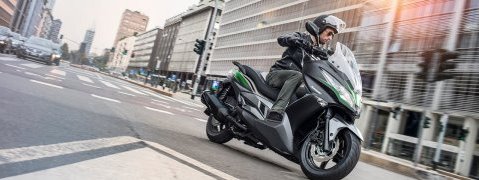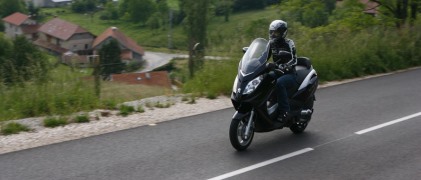 BMW C400GT - Rider's Manual > Technology in detail
BMW C400GT - Rider's Manual > Technology in detail
General notes
More information on the topic of technology is available at: bmw-motorrad.com/technology
Antilock Brake System (ABS)
How does ABS work?
The maximum braking force that can be transferred to the road surface is partially dependent on the friction coefficient of the road surface. Gravel, ice, snow and wet roads offer a considerably poorer friction coefficient than a dry, clean asphalt surface. The poorer the friction coefficient of the road surface is, the longer the braking distance will be.
If the maximum transferable brake force is exceeded when the rider increases the brake pressure, the wheels begin to lock and driving stability is lost.
A fall can result. Before this situation occurs, ABS intervenes and adjusts the brake pressure to the maximum transferable brake force. This enables the wheels to continue to turn and maintains riding stability regardless of the road condition.
What happens when rough roads are encountered?
Bumpy or rough roads can briefly lead to a loss of contact between the tires and the road surface, until the transferable braking force is reduced to zero. If braking is carried out in this situation, ABS reduces the brake pressure to ensure driving stability when restoring contact to the road. At this point, the BMW Motorrad ABS assumes extremely low friction coefficients (gravel, ice, snow) so that the running wheels turn in every imaginable case and the driving stability is ensured.
After detecting the actual conditions, the system adjusts the optimum brake pressure.
Lifting off rear wheel
On high-friction road surfaces, the front wheel will not block or will block very late, even if the brakes are applied forcefully. As a result, the ABS control intervenes very late or not at all. In this case, the rear wheel may rise up and cause the Scooter to roll over.
WARNING Lifting off of the rear wheel due to heavy braking
Accident hazard
- When braking heavily, bear in mind that the ABS control cannot always be relied on to prevent the rear wheel from lifting off the ground.
What are the design features of the BMW Motorrad ABS?
The BMW Motorrad ABS ensures stability on all surfaces, within the limits set by driving dynamics. The system is not optimized for the special conditions encountered under extreme weather during off-road and racetrack use.
Special situations
To detect the tendency of the wheels to lock up, the speeds of the front and rear wheel are compared. If implausible values are detected over a longer period of time, the ABS function is deactivated for safety reasons and an ABS error is indicated. A self-diagnosis routine must be completed before the error will be displayed.
Apart from problems on the BMW Motorrad ABS, unusual riding conditions can also cause a fault message to be generated.
Unusual riding conditions
- Rear wheel rotating with the vehicle held stationary by applying the front brake (burnout).
- Rear wheel slipping over a smooth roadway over a longer period, e.g. when decelerating with the braking effect of the engine.
Should a fault code occur due to an unusual driving condition, the ABS function can be reactivated by switching the ignition off and then on again.
How important is regular maintenance?
WARNING Brake system not regularly serviced
Accident hazard
- To ensure that the BMW Motorrad ABS is in a properly maintained condition, it is vital that the specified service intervals are kept to.
Reserves for safety
But remember, the potentially shorter braking distances which the BMW Motorrad ABS permits must not be used as an excuse for careless riding. ABS is primarily a means of ensuring a safety margin in genuine emergencies.
Be careful in curves! When you apply the brakes in curves, the laws of driving dynamics take over and even the BMW Motorrad ABS is unable to counteract their effects.
Automatic Stability Control (ASC)
How does ASC work?
BMW Motorrad ASC compares the wheel speeds of the front and rear wheels. Differences in the relative rotation speeds allow the system to determine the slip rate, and thus the stability reserves at the rear wheel. The engine management system adapts the engine torque when the slip limit is exceeded.
Special situations
As lean angles increase, acceleration potential is also progressively restricted by the laws of physics. This can result in delayed acceleration when coming out of very tight curves.
The system compares the rotation speeds of the front and rear wheels to detect any tendency for the rear wheel to spin or lose traction. If the system registers implausible data for an extended period of time it will deactivate the ASC functionality as safety precaution and a display will alert you to an ASC error. A self-diagnosis routine must be completed before the error will be displayed.
If the front wheel loses contact to the ground during extreme acceleration, the ASC reduces the engine torque until the front wheel touches the ground again.
BMW Motorrad recommends that you respond to this condition by twisting back the throttle grip somewhat to return to stable dynamic operating conditions as quickly as possible.
Never abruptly turn the throttle grip all the way back while on a smooth road surface. The engine's braking torque could cause the rear wheel to lock, resulting in unstable motorcycle conditions.
This case cannot be controlled by BMW Motorrad ASC.
Slippery roadway
On very loose surfaces (e.g. a gravel bed at a racetrack) the control interventions of the ASC can reduce the drive force at the rear wheel to such a degree that the rear wheel no longer turns sufficiently. In this case, BMW Motorrad recommends switching off the ASC temporarily.
Note that the rear wheel will spin on the loose surface, and close the throttle in a timely manner before reaching a solid surface.
Then switch on ASC again.
See also:
 BMW C400GT - Rider's Manual > Refueling
BMW C400GT - Rider's Manual > Refueling
without Keyless Ride OE WARNING Fuel is highly flammable Fire and explosion hazard Do not smoke. Never bring a naked flame near the fuel tank.







